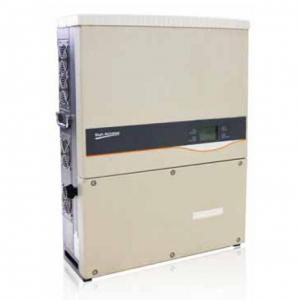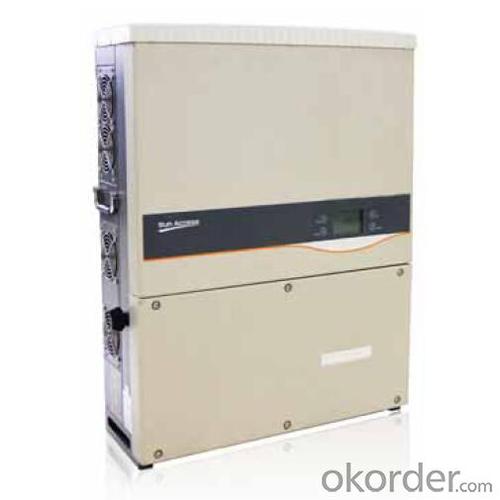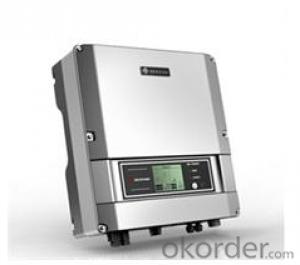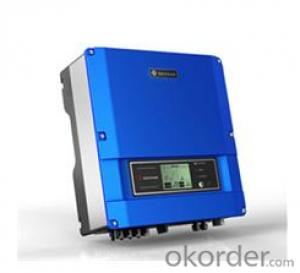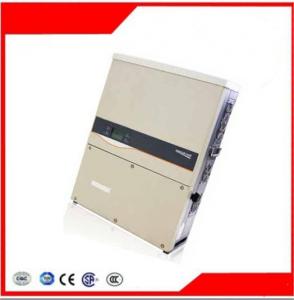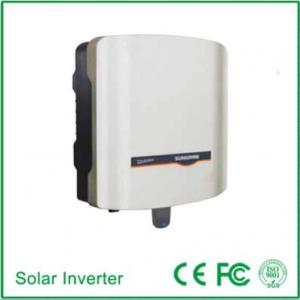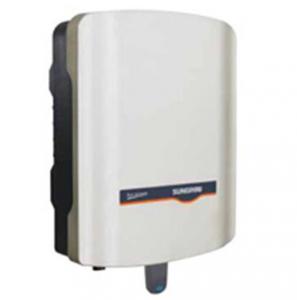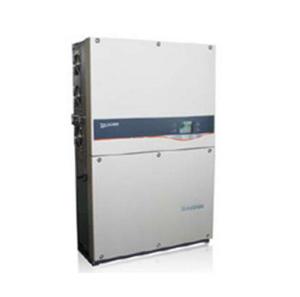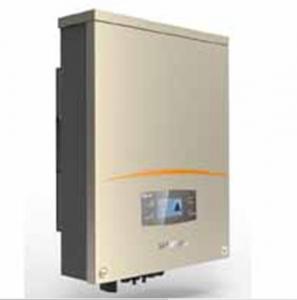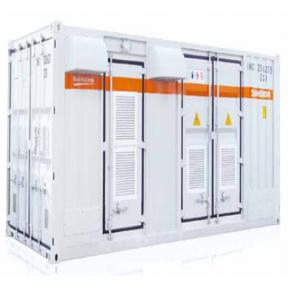250KW Solar Inverter Photovoltaic Grid-Connected Inverter SG40KTL
- Loading Port:
- China Main Port
- Payment Terms:
- TT or LC
- Min Order Qty:
- 50 unit
- Supply Capability:
- 10000 unit/month
OKorder Service Pledge
OKorder Financial Service
You Might Also Like
1. Structure of Photovoltaic Grid-Connected Inverter SG40KTL Description
A solar inverter, or PV inverter, or Solar converter, converts the variable direct current (DC) output of a photovoltaic (PV) solar panel into
autility frequency alternating current (AC) that can be fed into a commercial electrical grid or used by a local, off-grid electrical network.
It is acritical BOS–component in a photovoltaic system, allowing the use of ordinary AC-powered equipment.
Solar inverters have special functions adapted for use with photovoltaic arrays, including maximum power point tracking and anti-islanding protection.
Suitable for 50Hz/60Hz grid, could be used in Asia, Africa and Europe. Available for hand installation, no need for lifting machinery
assistance.
2. Main Features of the Photovoltaic Grid-Connected Inverter SG40KTL
• Full 36kW effective power at power factor of 0.9 due to apparent power reserves up to 39.8kVA
• Max. Efficiency at 98.3%
• Dual MPP trackers control
• Reduced cabling on AC side due to higher output voltage of 480Vac
• Integrated combiner box: 8 x MC4 connector pairs with DC string fuses, Type II overvoltage protection and DC switch, more safety and lower the system cost
• Can be wall-mounted without lifting equipment, weight 65 kg
• Active power continuously adjustable (0~100%)
• Reactive power control with power factor 0.8 overexcited ~ 0.8 underexcited
• Includes RS-485 interface, compatible with all common monitoring systems
• Product certification: TÜV, BDEW and CGC
• Manufacturer certification: ISO 9001, ISO 14001, OHSAS 18000
3. Photovoltaic Grid-Connected Inverter SG40KTL Images
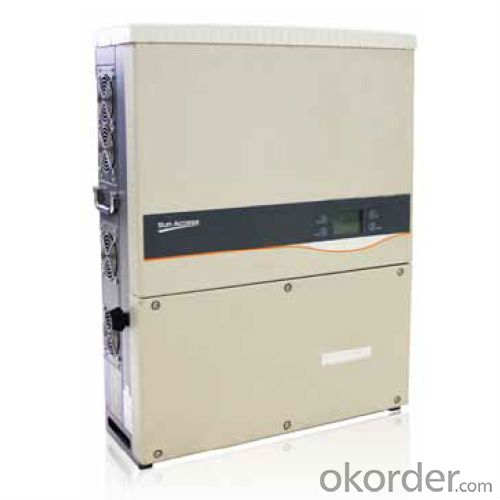
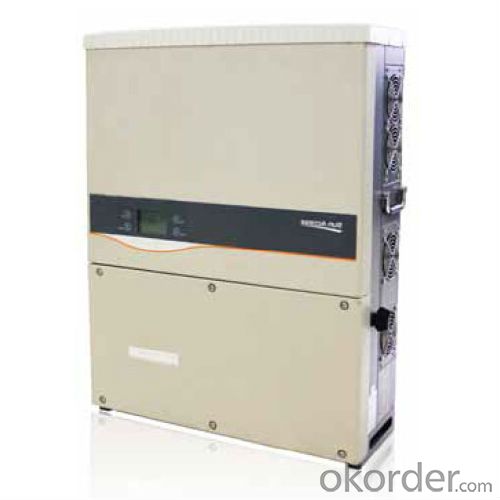
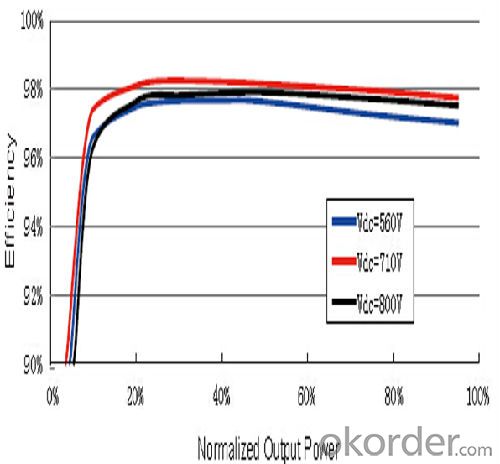
4. Photovoltaic Grid-Connected Inverter SG40KTL Specification
Input Side Data | |
Max. PV input power | 40500W |
Max. PV input voltage | 1000V |
Startup voltage | 300V |
Nominal input voltage | 710V |
MPP voltage range | 280~950V |
MPP voltage range for nominal power | 560~800V |
No. of MPPTs | 2 |
Max. number of PV strings per MPPT | 4 |
Max. PV input current | 66A(33A/33A) |
Max. current for input connector | 12A |
Output Side Data | |
Nominal AC output power | 36000W |
Max AC output power(PF=1) | 39800W |
Max. AC output apparent power | 39800VA |
Max. AC output current | 48A |
Nominal AC voltage | 3/N/PE, 277/480Vac or 3/PE, 480Vac |
AC voltage range | 422~528Vac |
Nominal grid frequency | 50Hz/60Hz |
Grid frequency range | 45~55Hz/55~ 65Hz |
THD | < 3 % (Nominal power) |
DC current injection | <0.5 %In |
Power factor | >0.99@default value at nominal power |
(adj. 0.8overexcited ~0.8underexited) | |
Protection | |
Anti-islanding protection | Yes |
LVRT | Yes |
DC reverse connection protection | Yes |
AC short circuit protection | Yes |
Leakage current protection | Yes |
DC switch | Yes |
DC fuse | Yes |
Overvoltage protection | DC Type II DIN rail surge arrester(40KA) |
System Data | |
Max. efficiency | 98.30% |
Max. European efficiency | 98.00% |
Isolation method | Transformerless |
Ingress protection rating | IP65 |
Night power consumption | <1W |
Operating ambient temperature range | -25~60℃(>45℃ derating) |
Allowable relative humidity range | 0~100% |
Cooling method | Smart forced air cooling |
Max. operating altitude | 4000m (>3000m derating) |
Display | Graphic LCD |
Communication | RS485(RJ45 connector) |
DC connection type | MC4 |
AC connection type | Screw Clamp terminal |
Certification | VDE0126-1-1, EN62109-1, EN62109-2,BDEW, |
CGC, NRS 097-2-1, GB/T 19964, UTE C15-712-1 | |
IEC 61683, IEC 60068-2, IEC61727, IEC62116, | |
IEC62109-1, IEC62109-2, EN50178, IEC62103, | |
EN61000-6-1, EN61000-6-2, EN61000-6-3, EN61000-6-4 | |
Mechanical Data | |
Dimensions(W×H×D) | 634×820×257mm |
Mounting method | Wall bracket |
Weight | 65kg |
5. FAQ of Photovoltaic Grid-Connected Inverter SG40KTL
Q1. What is the difference between inverter and solar inverter?
A1. Inverter only has AC inpput, but solar inverter both connect to AC input and solar panel, it saves more power.
Q2. What is the difference between MPPT&PWM?
A2. MPPT has higher efficiency, it can track the max power point and won't waste energy.
- Q: What is the role of a bypass switch in a solar inverter?
- The role of a bypass switch in a solar inverter is to provide a backup mechanism that allows the system to switch to the grid power in case of any issues or failures with the solar power generation. This ensures a continuous supply of electricity to the connected loads, even when the solar panels are not generating enough power or are experiencing problems.
- Q: How does a solar inverter handle voltage phase imbalance in the grid?
- A solar inverter handles voltage phase imbalance in the grid by monitoring the phase angles of the grid voltage and adjusting its output accordingly. It continuously measures the phase imbalance and corrects it by injecting reactive power into the grid. This helps to balance the voltage across the different phases and maintain stable grid conditions.
- Q: Can a solar inverter be used with different grid voltages or frequencies?
- No, a solar inverter cannot be used with different grid voltages or frequencies. Solar inverters are designed to convert the DC power generated by solar panels into AC power that matches the specific voltage and frequency of the local electrical grid. Using a solar inverter with different grid voltages or frequencies can lead to compatibility issues and may result in inefficient or malfunctioning operation of the system.
- Q: What are the common troubleshooting steps for a malfunctioning solar inverter?
- The common troubleshooting steps for a malfunctioning solar inverter include checking the display for error messages, inspecting the DC and AC connections for loose or damaged wires, verifying the input voltage and frequency, resetting the inverter, and monitoring the system for any unusual behavior. If these steps do not resolve the issue, it is advisable to consult a professional or contact the manufacturer for further assistance.
- Q: Can a solar inverter provide power during a blackout?
- No, a solar inverter cannot provide power during a blackout. This is because solar inverters are designed to convert the direct current (DC) electricity generated by solar panels into alternating current (AC) electricity for use in homes or businesses. However, during a blackout, the solar panels cannot generate electricity since the grid connection is lost, and therefore the solar inverter cannot provide power.
- Q: Can a solar inverter be used with a solar-powered emergency lighting system?
- Yes, a solar inverter can be used with a solar-powered emergency lighting system. A solar inverter is responsible for converting the direct current (DC) produced by solar panels into alternating current (AC) that can be used to power electrical devices. In the case of a solar-powered emergency lighting system, the solar panels generate DC power, which is then converted into AC power by the inverter to illuminate the emergency lights. This setup ensures that the emergency lighting system can function even during power outages or in remote areas where grid electricity is not available.
- Q: Can a solar inverter be used in off-grid systems?
- Yes, a solar inverter can be used in off-grid systems. In fact, it is an essential component of off-grid solar systems. The solar inverter is responsible for converting the DC power generated by the solar panels into AC power that can be used to run household appliances and charge batteries. This allows off-grid systems to store excess energy for use during periods of low sunlight, providing a reliable source of electricity even when disconnected from the grid.
- Q: Can a solar inverter be used in remote areas without access to the grid?
- Yes, a solar inverter can be used in remote areas without access to the grid. Solar inverters are designed to convert the direct current (DC) electricity generated by solar panels into alternating current (AC) electricity that can be used to power electrical devices. In remote areas, solar inverters can be used to harness the energy from the sun and provide a reliable and sustainable source of electricity, without the need for a connection to the grid.
- Q: Can a solar inverter be used with solar-powered signage systems?
- Yes, a solar inverter can be used with solar-powered signage systems. A solar inverter is responsible for converting the direct current (DC) produced by the solar panels into alternating current (AC) that can be used to power electrical devices. Since solar-powered signage systems also require AC power to operate, a solar inverter is necessary to ensure compatibility and efficient energy conversion.
- Q: What safety features should a solar inverter have?
- A solar inverter should have several safety features to ensure reliable and secure operation. These features may include overvoltage and undervoltage protection, ground fault protection, temperature monitoring, short circuit protection, and anti-islanding protection. Additionally, it should have built-in surge protection and be compliant with relevant safety standards to safeguard the system and prevent any potential hazards.
Send your message to us
250KW Solar Inverter Photovoltaic Grid-Connected Inverter SG40KTL
- Loading Port:
- China Main Port
- Payment Terms:
- TT or LC
- Min Order Qty:
- 50 unit
- Supply Capability:
- 10000 unit/month
OKorder Service Pledge
OKorder Financial Service
Similar products
Hot products
Hot Searches
Related keywords
